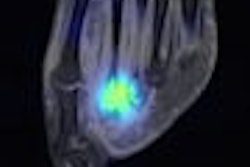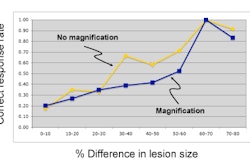The development of DICOM standards in teledermatology to increase patient access to potentially lifesaving care is taking a major step forward thanks, in part, to the U.S. Department of Veterans Affairs (VA) and the American Telemedicine Association (ATA).
Most recently, the initiative created practice guidelines that recommend the use of DICOM for store-and-forward teledermatology to correctly couple patient information and identifiers with the appropriate images.
"The reason [dermatologists] want to move toward DICOM is so those images, when they are archived by the dermatologist or the consultant at the reading site, would contain patient identification information," said Peter Kuzmak, DICOM software developer with the VA's Veterans Health Information Systems and Technology Architecture (VISTA). "The goal is to move teledermatology from its own discipline into the mainstream of medical imaging ... and make dermatology consultants more available to patients."
Skin cancer kills about one-fifth as many people as breast cancer, and patient access to dermatologists can be limited in some parts of the U.S. With store-and-forward capabilities, a primary care physician could transmit a digital image to a dermatology clinic for consultation, just as he or she would in teleradiology applications. In addition, video also could be transmitted via DICOM for dermatologists to examine patients remotely.
Image transmission
Typically, a consumer-grade camera takes JPEG images of a patient's condition and those pictures are sent via e-mail with attachments using regular automation tools. "The problem is that the images lack patient identification information," said Kuzmak in his presentation at the 2008 Society for Imaging Informatics in Medicine (SIIM) meeting.
The VA currently is building a national teledermatology project based on the software that has been used previously to create a national network for diabetic patients. That software and infrastructure handles some 90,000 studies.
Using the technology as a generic infrastructure, the teledermatology program is replacing the image acquisition portion of the diabetic application with DICOM image acquisition software and a consumer-grade digital camera that Kuzmak estimates can be purchased for approximately $400.
Program expansion
The plan is to staff various VA facilities with dermatology reading sites and send the images there for interpretation. Phase one included only one workstation acquiring images; phase two will expand the effort to the southeastern and midwestern U.S., using 29 image acquisition workstations. Phase three will extend the technology to multiple outpatient clinics and medical centers and eventually to patient home care.
When working with small private dermatology offices, Kuzmak said the classic DICOM service over a wide area network was a limitation because of its expense and lack of proper network connectivity. "A dermatologist will send images to multiple specialists, because with 200 different diseases, these specialists are specialists in all diseases," he said. "Second, you have to deal with maintaining the network activity, there are security hurdles, and private practices want an economical, simple, secure solution."
With the help of a new DICOM e-mail transport protocol, e-mails will work with ordinary automation office technology and minimal user interaction or training. The DICOM e-mail transport bundles a set of DICOM files, attaches them to the e-mail, and sends them securely to its destination.
DICOM ZIP files
After the images are sent to an electronic folder, the folder is concerted into an Integrating the Healthcare Enterprise (IHE)-compatible file set with the addition of a DICOM directory file. It is then compressed into a ZIP file archive and attached to the e-mail. Additional files may be included before the e-mail is encrypted and sent to its recipient.
A referring physician using the teledermatology application would take the DICOM images, process them, enter a message, and send the files to a dermatologist or consultant. The DICOM directory file is downloaded, unzipped, and imported to the PACS for the dermatologist or consultant to read and interpret.
Kuzmak noted two limitations in his presentation. Given that teleradiology uses lossy JPEG compressed images, compression is needed to minimize the size of the DICOM ZIP file. Thus, media storage application profiles must be updated.
In addition, rather than use the conventional "DICOM.ZIP" name, the standard should specify a "unique file extension, so that the attachment can be automatically associated with the file open program. Also, many firewalls block ZIP attachments, another reason why a different extension should be used," Kuzmak said.
By Wayne Forrest
AuntMinnie.com staff writer
July 15, 2008
Related Reading
Telemammography project achieves success, April 28, 2008
Telehealth program cuts costs, helps patients improve health, March 31, 2008
Remote island gets telemedicine capability, November 14, 2007
Alaska telehealth project improves efficiency, access to care, February 27, 2007
Copyright © 2008 AuntMinnie.com



















